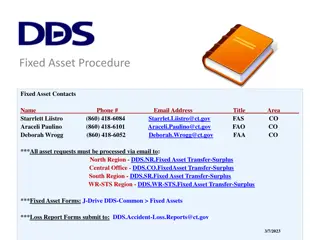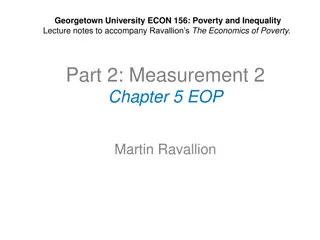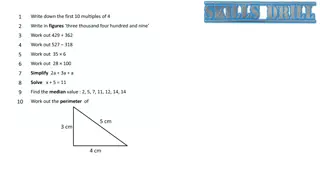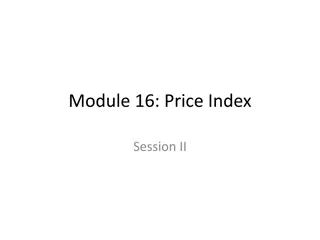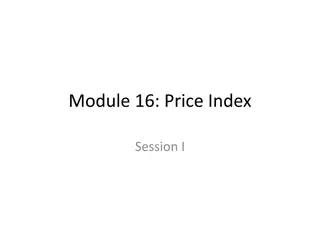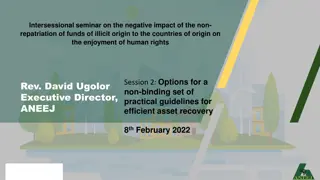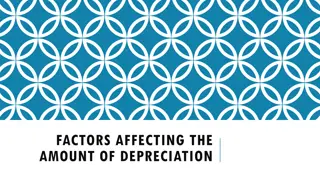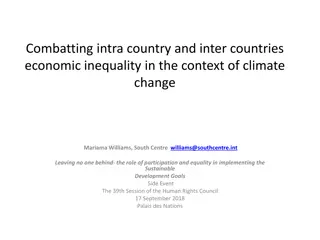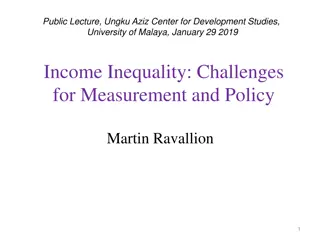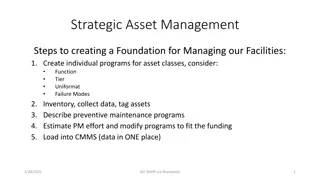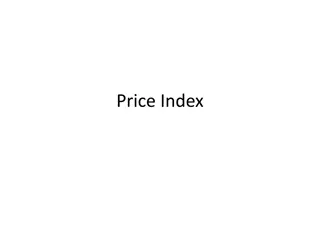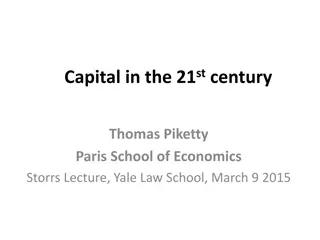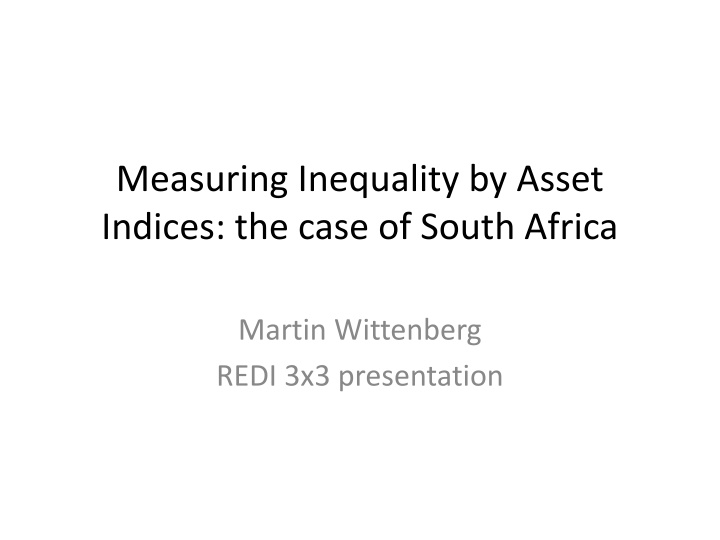
Asset Indices and Inequality Measures in South Africa
Explore the challenges and insights of measuring inequality using asset indices in South Africa. Learn about the methods, interpretations, and motivations behind asset indices and their implications for assessing wealth distribution and changes in inequality over time.
Download Presentation

Please find below an Image/Link to download the presentation.
The content on the website is provided AS IS for your information and personal use only. It may not be sold, licensed, or shared on other websites without obtaining consent from the author. If you encounter any issues during the download, it is possible that the publisher has removed the file from their server.
You are allowed to download the files provided on this website for personal or commercial use, subject to the condition that they are used lawfully. All files are the property of their respective owners.
The content on the website is provided AS IS for your information and personal use only. It may not be sold, licensed, or shared on other websites without obtaining consent from the author.
E N D
Presentation Transcript
Measuring Inequality by Asset Indices: the case of South Africa Martin Wittenberg REDI 3x3 presentation
Overall argument: the negative Main methods of generating asset indices (PCA, Factor Analysis, MCA) look for correlations between different assets Latent variable interpretation: what is common to the assets must be wealth This breaks down when there are assets that are particular to sub-groups (rural areas) such as livestock These assets are typically negatively correlated with the other assets Resulting index will violate the assumption that people with a lower score always have less stuff than people with a higher score
Overall argument: the positive It is possible to construct indices in a way which sidesteps these issues In the process it is possible to give a cardinal interpretation to the indices, i.e. we can estimate inequality measures with them When applying these measures to South African data we find that "asset inequality" has decreased markedly between 1993 and 2008 This contrasts with the money-metric measures If incomes rise across the board then asset holdings with a static schedule will show increases in attainment while inequality will stay constant BUT Creation of asset indices should proceed carefully -- examining whether the implied coefficients make sense
Motivation Asset indices have become very widely used in the development literature, particularly with the release of the DHS wealth indices 13 900 "hits" for "DHS wealth index" on Google Scholar 2 434 Google Scholar citations of the Filmer and Pritchett article 591 Google Scholar citations of the Rutstein and Johnson (DHS wealth index) paper Use of these indices has been externally validated (e.g. against income) But in at least some cases they are internally inconsistent (as we will show) Asset indices have proved extremely useful in broadly separating "poor" from the "rich Cannot use indices to measure inequality or changes in inequality -- yet in some cases assets is all we have
Literature: Principal Components The Filmer and Pritchett (2001) paper argued that the first principal component of a series of asset variables should be thought of as "wealth". This interpretation has underpinned its adoption by the DHS as the default approach for creating the DHS wealth index
Latent variable interpretation Write asset equations as ?1= ?11?1+ ?21?2+ + ??1?? ?2= ?12?1+ ?22?2+ + ??2?? ??= ?1??1+ ?2??2+ + ????? with A1,A2 ,Akmutually orthogonal Then A1is the variable that explains most of what is common to the assets ai
The mechanics Variables are standardized (de-meaned, divided by their standard deviations) The scoring coefficients are given by the first eigenvector of the correlation matrix Consequences: Asset indices have mean zero (i.e. can t use traditional inequality measures on them) The implicit weights on each of the assets are a combination of the score and the standardization Generally not reported/interrogated
Starting from scratch Desirable properties: Asset index should be monotonic (people that have more, should be ranked higher) Somebody who has no assets should get a score of zero Implies that we are not including bads Approach should work both with binary and with continuous data
Thinking about inequality using binary variables Many of the traditional thought experiments don t work in this context: e.g. there is no way to do a transfer from a richer to a poorer person while keeping their ranks in the distribution unchanged It is impossible to scale all holdings up by an arbitrary constant
The case of one dummy variable Plot the Lorenz curve Gini coefficient is just 1 ? Maximal inequality when p= Decreases monotonically as p goes to one Similar view of inequality when using coefficient of variation
Two binary variables One additional complication that occurs when you have more than one variable is dealing with the case of a correlation increasing transfer e.g. the asset holdings (1,0) and (0,1) versus (0,0) and (1,1) Most people would judge the second distribution to be more unequal than the first
PCA index We can derive expressions of the value of the PCA index as a function of the proportions p1and p2who hold assets 1 and 2 respectively and p12 the fraction who hold both The range (and the variance) of the index shows a U shape with minimum near p1(the more commonly held asset) Unbounded near 0 and 1
More critically The assets will be negatively correlated whenever p12 p1p2 In this case one of the assets will score a negative weight in the index 1 .8 .6 a2 .4 .2 0 0 .2 .4 .6 .8 1 a1
Why is this the case? The latent variable approach can make sense of the negative correlation only if one of the assets is reinterpreted as a bad , e.g. a1 This will result in the rankings: ? 0,1 ? 1,1 and ? 0,0 ? 1,0 Not hard to construct examples where (1,1) scores lower than (0,0) Is this relevant? Yes! Empirical work
Banerjees Multidimensional Gini Create an uncentered version of the principal components procedure: Divide every variable by its mean (in the binary variable case pi) This makes the procedure scale independent In the continuous variable case It has the side-effect of paying more attention to scarce assets in the binary variable case BUT this will also prove troublesome in some empirical cases Then extract the first principal component of the cross- product matrix Calculate Gini coefficient on this index
What does this do? This procedure is guaranteed to give non- negative scores Banerjee proves that the Gini calculated in this way obeys (using continuous variables) obeys all the standard inequality axioms PLUS it will show an increase in inequality if a correlation increasing transfer is effected
In the case of asset indices It is guaranteed to give an asset index that obeys the principle of monotonicity It will have an absolute zero And it can be used to calculate Gini coefficients even when all variables are binary variables.
Application to the DHS wealth index VARIABLES water in house electricity DHS WI UC PCA UC PCA2 PCA PCA2 MCA FA 0.252*** 0.180*** 0.209 0.0814 0.565 0.220 0.708 0.663 0.707 0.657 0.329 0.300 0.289 0.265 radio television 0.0978*** 0.160*** 0.0515 0.101 0.140 0.273 0.467 0.678 0.477 0.680 0.206 0.312 0.113 0.301 refrigerator 0.179*** 0.136 0.369 0.735 0.738 0.343 0.413 bicycle m.cycle car 0.0923*** 0.169*** 0.175*** 0.600 52.57 0.490 1.401 0.490 0.788 0.766 0.501 0.821 0.777 0.233 0.412 0.368 0.137 0.193 0.320 1.202 rooms telephone PC washing machine 0.0102*** 0.196*** 0.210*** 0.0176 0.378 4.984 0.0482 0.989 14.42 0.0977 0.813 0.967 0.105 0.818 0.982 CAT 0.387 0.481 0.0221 0.397 0.296 0.203*** 0.654 1.696 0.870 0.877 0.421 0.452 donkey/horse -0.0880*** 2.836 4.523 -0.293 -0.118 -0.0849 sheep/cattle -0.118*** 0.291 0.509 -0.375 -0.156 -0.0909 Observations R-squared 11,666 0.999 12,136 1.000 12,136 1.000 12,136 1.000 12,136 1.000 12,136 1.000 12,136 1.000
Comparing the PCA 2 and UC PCA2 rankings Quantiles of PCA 2 Quantiles of UC PCA2 1 2 3 4 5 Total 1 2 368 482 0 0 0 2 850 2 530 1 145 748 0 0 2 423 3 34 429 1 277 586 0 2 326 4 0 66 275 1 463 399 2 203 5 175 104 55 84 1 912 2 330 Total 3 107 2 226 2 355 2 133 2 311 12 132
Comparing the rankings DHS WI PCA PCA 2 MCA FA UC PCA UC PCA 2 DHS WI 1 PCA 0.9435 1 PCA 2 0.9337 0.9974 1 MCA 0.94 0.999 0.9973 1 FA 0.9449 0.9968 0.9952 0.9959 1 UC PCA 0.3059 0.3862 0.3995 0.3956 0.362 1 UC PCA 2 0.6247 0.7391 0.7559 0.747 0.7234 0.4539 1
Proportion poor (bottom 40%) Linearized Std. Err. Over DHS capital, large city small city town countryside PCA 2 capital, large city small city town countryside UC PCA 2 capital, large city small city town countryside Mean [95% Conf. Interval] 0.098 0.178 0.204 0.720 0.013 0.024 0.031 0.020 0.072 0.131 0.142 0.681 0.123 0.225 0.265 0.759 0.146 0.220 0.291 0.648 0.014 0.021 0.032 0.019 0.119 0.179 0.229 0.610 0.173 0.261 0.353 0.686 0.198 0.275 0.372 0.597 0.015 0.022 0.033 0.016 0.169 0.232 0.308 0.566 0.227 0.317 0.437 0.628
Asset inequality by area Group Estimate STE LB UB 1: capital, large city 0.566 0.009 0.549 0.583 2: small city 0.538 0.014 0.511 0.566 3: town 0.569 0.023 0.524 0.614 4: countryside 0.609 0.014 0.582 0.636 Population 0.623 0.007 0.610 0.636
South Africa 1993-2008 Lorenz Curves 1 .8 .6 L(p) .4 .2 0 0 .2 .4 .6 .8 1 Percentiles (p) Population 45 line 1993 2008
Asset holdings Linearized Over Mean Std. Err. [95% Conf. Interval] electricity 1993 2008 0.459 0.779 0.024 0.020 0.411 0.740 0.507 0.818 Piped water 1993 0.506 0.027 0.454 0.559 2008 0.697 0.811 0.025 0.008 0.648 0.796 0.746 0.826 radio 1993 2008 0.694 0.012 0.672 0.717 TV 1993 0.477 0.703 0.018 0.017 0.441 0.671 0.512 0.736 2008 Fridge 1993 0.399 0.020 0.360 0.438 2008 1993 0.609 0.247 0.020 0.016 0.569 0.215 0.648 0.279 Motor 2008 0.220 0.018 0.184 0.256 Livestock 1993 0.110 0.100 0.011 0.011 0.089 0.078 0.132 0.122 2008 Land line 1993 0.242 0.018 0.206 0.278 2008 0.143 0.807 0.015 0.011 0.114 0.786 0.172 0.828 Cell phone 2008 Any phone 1993 0.242 0.827 0.018 0.010 0.206 0.808 0.278 0.847 2008
South Africa - Assets Lorenz Curves 1 .8 .6 L(p) .4 .2 0 0 .2 .4 .6 .8 1 Percentiles (p) Population 45 line 1993 2008
Why the difference? Incomes have increased across the board Inequality stayed constant Asset register, however, is fixed: Higher proportions of South Africans have access to these Hence this measure goes down The two methods really ask different questions Asset inequality measure looks at the gap between the haves and the have nots Is scale dependent Income inequality looks at the distribution of incomes, where essentially everyone has something Is scale independent

